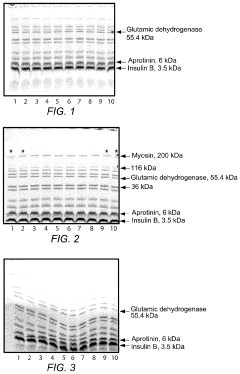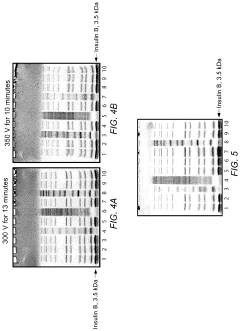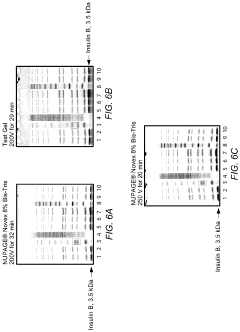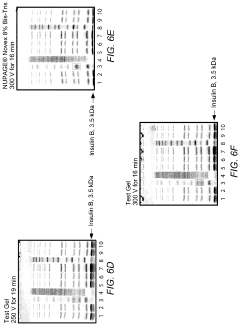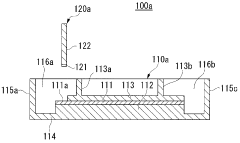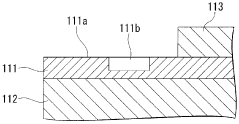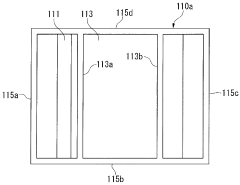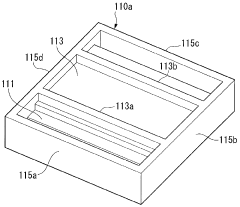How to Enhance Specificity with Gel Electrophoresis?
JUN 30, 20259 MIN READ
Generate Your Research Report Instantly with AI Agent
Patsnap Eureka helps you evaluate technical feasibility & market potential.
Gel Electrophoresis Background and Objectives
Gel electrophoresis has been a cornerstone technique in molecular biology since its inception in the 1960s. This method, which separates molecules based on their size and electrical charge, has revolutionized the field of biochemistry and molecular biology. The technique's ability to separate DNA, RNA, and proteins has made it an indispensable tool in various applications, from forensic science to genetic research.
The primary objective of enhancing specificity in gel electrophoresis is to improve the resolution and accuracy of molecule separation. This goal is driven by the increasing demand for more precise analytical methods in fields such as genomics, proteomics, and personalized medicine. As research delves into more complex molecular structures and minute genetic variations, the need for highly specific separation techniques becomes paramount.
The evolution of gel electrophoresis has seen significant advancements over the years. From the initial use of starch gels, the field progressed to agarose and polyacrylamide gels, each offering improved resolution for different molecule sizes. The introduction of pulsed-field gel electrophoresis (PFGE) in the 1980s marked a significant milestone, allowing for the separation of much larger DNA fragments than previously possible.
Recent technological trends in gel electrophoresis focus on miniaturization, automation, and integration with other analytical techniques. Microfluidic devices and capillary electrophoresis systems have emerged as powerful tools for high-throughput analysis. These advancements aim to address the limitations of traditional gel electrophoresis, such as long run times and the need for large sample volumes.
The quest for enhanced specificity in gel electrophoresis is driven by several factors. First, the growing field of personalized medicine requires more accurate detection of genetic variations and biomarkers. Second, the increasing complexity of biological research demands higher resolution in separating closely related molecules. Lastly, the need for faster and more cost-effective analytical methods in both research and clinical settings continues to push the boundaries of gel electrophoresis technology.
As we look towards the future, the objectives for enhancing specificity in gel electrophoresis are multifaceted. These include developing novel gel matrices with improved separation properties, optimizing buffer systems for better resolution, and integrating advanced detection methods for increased sensitivity. Additionally, there is a growing emphasis on creating user-friendly, automated systems that can provide highly specific results with minimal human intervention.
The primary objective of enhancing specificity in gel electrophoresis is to improve the resolution and accuracy of molecule separation. This goal is driven by the increasing demand for more precise analytical methods in fields such as genomics, proteomics, and personalized medicine. As research delves into more complex molecular structures and minute genetic variations, the need for highly specific separation techniques becomes paramount.
The evolution of gel electrophoresis has seen significant advancements over the years. From the initial use of starch gels, the field progressed to agarose and polyacrylamide gels, each offering improved resolution for different molecule sizes. The introduction of pulsed-field gel electrophoresis (PFGE) in the 1980s marked a significant milestone, allowing for the separation of much larger DNA fragments than previously possible.
Recent technological trends in gel electrophoresis focus on miniaturization, automation, and integration with other analytical techniques. Microfluidic devices and capillary electrophoresis systems have emerged as powerful tools for high-throughput analysis. These advancements aim to address the limitations of traditional gel electrophoresis, such as long run times and the need for large sample volumes.
The quest for enhanced specificity in gel electrophoresis is driven by several factors. First, the growing field of personalized medicine requires more accurate detection of genetic variations and biomarkers. Second, the increasing complexity of biological research demands higher resolution in separating closely related molecules. Lastly, the need for faster and more cost-effective analytical methods in both research and clinical settings continues to push the boundaries of gel electrophoresis technology.
As we look towards the future, the objectives for enhancing specificity in gel electrophoresis are multifaceted. These include developing novel gel matrices with improved separation properties, optimizing buffer systems for better resolution, and integrating advanced detection methods for increased sensitivity. Additionally, there is a growing emphasis on creating user-friendly, automated systems that can provide highly specific results with minimal human intervention.
Market Demand Analysis for Enhanced Specificity
The market demand for enhanced specificity in gel electrophoresis has been steadily growing, driven by the increasing need for more precise and reliable analytical techniques in various scientific and industrial fields. This demand is particularly pronounced in sectors such as molecular biology, genetics, forensics, and pharmaceutical research, where accurate separation and identification of biomolecules are crucial.
In the field of molecular biology and genetics, the push for enhanced specificity in gel electrophoresis is fueled by the rapid advancements in genomic research and personalized medicine. Researchers require more sensitive and specific techniques to detect and analyze minute genetic variations, single nucleotide polymorphisms (SNPs), and rare genetic markers. This has led to a growing market for high-resolution gel electrophoresis systems and specialized reagents that can provide superior specificity.
The pharmaceutical industry represents another significant driver of market demand for enhanced specificity in gel electrophoresis. As drug development processes become more complex and targeted, there is an increasing need for analytical techniques that can accurately separate and identify specific proteins, peptides, and other biomolecules. This is particularly important in the development of biopharmaceuticals and the characterization of complex biological samples.
Forensic science is another area where the demand for enhanced specificity in gel electrophoresis is on the rise. The ability to accurately analyze DNA samples with high specificity is crucial for criminal investigations and legal proceedings. This has led to increased investment in advanced gel electrophoresis technologies that can provide more reliable and court-admissible results.
The market for enhanced specificity in gel electrophoresis is also being driven by the growing emphasis on quality control and regulatory compliance in various industries. For instance, in the food and beverage sector, there is a rising demand for techniques that can accurately detect and identify specific contaminants, allergens, or genetically modified organisms (GMOs) in food products.
As research institutions and industrial laboratories strive to improve their analytical capabilities, there is a growing trend towards the adoption of automated and high-throughput gel electrophoresis systems. These systems not only offer enhanced specificity but also improve efficiency and reproducibility, making them attractive to laboratories dealing with large sample volumes.
The market demand is further bolstered by the increasing focus on precision medicine and biomarker discovery. Researchers and clinicians require highly specific analytical tools to identify and validate biomarkers for various diseases, driving the need for advanced gel electrophoresis techniques that can provide superior resolution and specificity.
In the field of molecular biology and genetics, the push for enhanced specificity in gel electrophoresis is fueled by the rapid advancements in genomic research and personalized medicine. Researchers require more sensitive and specific techniques to detect and analyze minute genetic variations, single nucleotide polymorphisms (SNPs), and rare genetic markers. This has led to a growing market for high-resolution gel electrophoresis systems and specialized reagents that can provide superior specificity.
The pharmaceutical industry represents another significant driver of market demand for enhanced specificity in gel electrophoresis. As drug development processes become more complex and targeted, there is an increasing need for analytical techniques that can accurately separate and identify specific proteins, peptides, and other biomolecules. This is particularly important in the development of biopharmaceuticals and the characterization of complex biological samples.
Forensic science is another area where the demand for enhanced specificity in gel electrophoresis is on the rise. The ability to accurately analyze DNA samples with high specificity is crucial for criminal investigations and legal proceedings. This has led to increased investment in advanced gel electrophoresis technologies that can provide more reliable and court-admissible results.
The market for enhanced specificity in gel electrophoresis is also being driven by the growing emphasis on quality control and regulatory compliance in various industries. For instance, in the food and beverage sector, there is a rising demand for techniques that can accurately detect and identify specific contaminants, allergens, or genetically modified organisms (GMOs) in food products.
As research institutions and industrial laboratories strive to improve their analytical capabilities, there is a growing trend towards the adoption of automated and high-throughput gel electrophoresis systems. These systems not only offer enhanced specificity but also improve efficiency and reproducibility, making them attractive to laboratories dealing with large sample volumes.
The market demand is further bolstered by the increasing focus on precision medicine and biomarker discovery. Researchers and clinicians require highly specific analytical tools to identify and validate biomarkers for various diseases, driving the need for advanced gel electrophoresis techniques that can provide superior resolution and specificity.
Current Challenges in Gel Electrophoresis Specificity
Gel electrophoresis is a fundamental technique in molecular biology, widely used for separating and analyzing nucleic acids and proteins. However, despite its widespread application, several challenges persist in achieving optimal specificity. One of the primary issues is the occurrence of non-specific bands or smears, which can obscure results and lead to misinterpretation of data.
The resolution of gel electrophoresis is often limited by factors such as gel composition, buffer conditions, and electric field strength. Achieving high resolution, particularly for molecules with similar sizes or charges, remains a significant challenge. This limitation can result in overlapping bands or poor separation of target molecules, reducing the overall specificity of the technique.
Another critical challenge is the sensitivity of gel electrophoresis, especially when dealing with low-abundance samples. The detection of rare or low-copy-number molecules can be problematic, as they may be masked by more abundant species or fall below the detection threshold of common staining methods. This sensitivity issue directly impacts the specificity of the technique, as it may lead to false negatives or underestimation of certain molecular species.
The loading capacity of gels presents another hurdle in enhancing specificity. Overloading can result in band distortion and poor resolution, while underloading may lead to weak or undetectable signals. Striking the right balance is crucial for obtaining clear, specific results, but this can be challenging, especially when working with complex samples or unknown concentrations.
Cross-contamination between samples is a persistent issue that can significantly compromise specificity. This can occur during sample preparation, loading, or even during the electrophoresis process itself, leading to false positive results or misidentification of bands. Ensuring complete separation between lanes and preventing sample spillover are ongoing challenges in maintaining high specificity.
The choice of staining method also plays a critical role in specificity. While many staining techniques are available, each comes with its own set of limitations. Some may have high background noise, others may have limited dynamic range, and some may interact differently with various types of molecules, potentially leading to biased or incomplete results.
Lastly, the interpretation of gel electrophoresis results remains a challenge, particularly in complex samples or when dealing with novel molecules. Distinguishing between specific and non-specific bands, accurately sizing molecules, and quantifying band intensities all require expertise and can be subject to human error. This interpretative challenge directly impacts the perceived specificity of the technique and its reliability in various applications.
Addressing these challenges is crucial for enhancing the specificity of gel electrophoresis. Innovations in gel materials, buffer systems, and detection methods, along with improved standardization and data analysis techniques, are key areas of focus for overcoming these limitations and improving the overall reliability and specificity of this essential laboratory technique.
The resolution of gel electrophoresis is often limited by factors such as gel composition, buffer conditions, and electric field strength. Achieving high resolution, particularly for molecules with similar sizes or charges, remains a significant challenge. This limitation can result in overlapping bands or poor separation of target molecules, reducing the overall specificity of the technique.
Another critical challenge is the sensitivity of gel electrophoresis, especially when dealing with low-abundance samples. The detection of rare or low-copy-number molecules can be problematic, as they may be masked by more abundant species or fall below the detection threshold of common staining methods. This sensitivity issue directly impacts the specificity of the technique, as it may lead to false negatives or underestimation of certain molecular species.
The loading capacity of gels presents another hurdle in enhancing specificity. Overloading can result in band distortion and poor resolution, while underloading may lead to weak or undetectable signals. Striking the right balance is crucial for obtaining clear, specific results, but this can be challenging, especially when working with complex samples or unknown concentrations.
Cross-contamination between samples is a persistent issue that can significantly compromise specificity. This can occur during sample preparation, loading, or even during the electrophoresis process itself, leading to false positive results or misidentification of bands. Ensuring complete separation between lanes and preventing sample spillover are ongoing challenges in maintaining high specificity.
The choice of staining method also plays a critical role in specificity. While many staining techniques are available, each comes with its own set of limitations. Some may have high background noise, others may have limited dynamic range, and some may interact differently with various types of molecules, potentially leading to biased or incomplete results.
Lastly, the interpretation of gel electrophoresis results remains a challenge, particularly in complex samples or when dealing with novel molecules. Distinguishing between specific and non-specific bands, accurately sizing molecules, and quantifying band intensities all require expertise and can be subject to human error. This interpretative challenge directly impacts the perceived specificity of the technique and its reliability in various applications.
Addressing these challenges is crucial for enhancing the specificity of gel electrophoresis. Innovations in gel materials, buffer systems, and detection methods, along with improved standardization and data analysis techniques, are key areas of focus for overcoming these limitations and improving the overall reliability and specificity of this essential laboratory technique.
Existing Methods for Improving Specificity
01 Gel composition and preparation
Specific gel compositions and preparation methods are crucial for enhancing the specificity of gel electrophoresis. This includes the use of particular polymers, cross-linking agents, and buffer systems to create gels with optimal pore sizes and separation properties for different types of molecules.- Gel composition and preparation: The specificity of gel electrophoresis can be improved by optimizing the gel composition and preparation methods. This includes using specific polymers, cross-linking agents, and buffer systems to create gels with desired pore sizes and separation properties. The gel composition can be tailored to enhance the resolution of specific biomolecules or to separate molecules within a particular size range.
- Sample preparation techniques: Proper sample preparation is crucial for improving the specificity of gel electrophoresis. This includes methods for concentrating samples, removing interfering substances, and optimizing sample loading conditions. Techniques such as sample purification, desalting, and the use of specific loading buffers can enhance the resolution and specificity of the separation process.
- Electrophoresis conditions optimization: The specificity of gel electrophoresis can be enhanced by optimizing various electrophoresis conditions. This includes adjusting parameters such as voltage, current, temperature, and run time. Additionally, the use of pulsed-field gel electrophoresis or gradient gel electrophoresis techniques can improve the separation of specific types of molecules.
- Detection and visualization methods: Improving the detection and visualization of separated molecules can enhance the specificity of gel electrophoresis. This includes the use of specific staining techniques, fluorescent labels, or immunodetection methods. Advanced imaging and analysis software can also be employed to improve the resolution and quantification of separated bands.
- Specialized gel electrophoresis techniques: Various specialized gel electrophoresis techniques have been developed to improve specificity for particular applications. These include two-dimensional gel electrophoresis, capillary gel electrophoresis, and microfluidic gel electrophoresis systems. These techniques can offer enhanced resolution and specificity for complex sample mixtures or specific types of biomolecules.
02 Sample preparation and loading techniques
Improved sample preparation and loading techniques can significantly increase the specificity of gel electrophoresis. This involves methods for concentrating samples, removing interfering substances, and precisely applying samples to the gel to achieve better resolution and separation.Expand Specific Solutions03 Electrophoresis conditions optimization
Optimizing electrophoresis conditions, such as voltage, current, and run time, can enhance the specificity of gel electrophoresis. This includes developing protocols for gradient electrophoresis, pulsed-field gel electrophoresis, and other specialized techniques to improve separation of specific molecule types.Expand Specific Solutions04 Detection and visualization methods
Advanced detection and visualization methods can increase the specificity of gel electrophoresis by improving the ability to identify and quantify specific molecules. This includes the use of fluorescent dyes, chemiluminescent reagents, and specialized imaging systems to enhance sensitivity and resolution.Expand Specific Solutions05 Microfluidic and miniaturized systems
Development of microfluidic and miniaturized gel electrophoresis systems can improve specificity by allowing for more precise control over separation conditions and reducing sample volume requirements. These systems often incorporate novel materials and fabrication techniques to enhance performance.Expand Specific Solutions
Key Players in Gel Electrophoresis Industry
The gel electrophoresis market is in a mature stage, with established players and well-defined applications. The global market size is estimated to be in the billions of dollars, driven by increasing demand in genomics, proteomics, and clinical diagnostics. Technologically, gel electrophoresis has evolved significantly, with companies like Life Technologies Corp., Agilent Technologies, and Bio-Techne (ProteinSimple) leading innovations in automation, sensitivity, and resolution. These advancements have enhanced specificity, addressing key challenges in molecular separation. Emerging players such as CovalX AG are introducing novel approaches, while traditional powerhouses like Beckman Coulter and Applied Biosystems continue to refine their offerings, maintaining a competitive landscape that balances innovation with reliability.
Life Technologies Corp.
Technical Solution: Life Technologies, now part of Thermo Fisher Scientific, has developed the E-Gel™ electrophoresis system, which uses pre-cast agarose gels to enhance specificity and reproducibility in nucleic acid separation. The E-Gel system incorporates a novel buffer-free technology, reducing the risk of contamination and improving consistency across runs[7]. Life Technologies has also introduced the Attune NxT Flow Cytometer, which, while not a gel electrophoresis system, complements electrophoresis by providing high-resolution analysis of individual cells and particles, enhancing overall specificity in biomolecule characterization[8].
Strengths: Simplified workflow, reduced contamination risk, and integration with other analytical platforms. Weaknesses: Limited flexibility in gel composition and potential higher per-run costs compared to traditional methods.
Agilent Technologies, Inc.
Technical Solution: Agilent Technologies has developed advanced gel electrophoresis systems that enhance specificity through multiple innovations. Their 2100 Bioanalyzer system utilizes microfluidic technology to perform automated electrophoresis, providing high-resolution separation of DNA, RNA, and proteins[1]. The system incorporates laser-induced fluorescence detection, allowing for sensitive quantification of nucleic acids and proteins. Agilent has also introduced the TapeStation systems, which use pre-cast gels in a cartridge format, offering rapid and reproducible electrophoresis results[2]. These systems employ specialized software for data analysis, enhancing the specificity of band detection and quantification.
Strengths: High automation, rapid results, and precise quantification. Weaknesses: Higher cost compared to traditional gel electrophoresis methods, and potential limitations in customization for specialized applications.
Innovative Approaches in Gel Electrophoresis
System for rapid high-resolution GEL electrophoresis
PatentActiveUS20190391113A1
Innovation
- The development of electrophoretic systems and formulations that allow for higher field strengths up to 50% more than conventional systems, using a discontinuous buffer system with specific gel amine and ampholyte buffers, and a pH range of 5.5 to 7.5, enabling faster separation of proteins within 30 minutes or less, even at higher voltages.
Instrument for electrophoresis and electrophoresis apparatus
PatentWO2011078159A1
Innovation
- An electrophoresis instrument with a sample separation section and a sample transport unit that includes a positioning section to accurately connect the sample-containing medium to the sample separation medium, ensuring the relationship Z≧0.4×X is maintained, enhancing the connection precision and stability of the gels during electrophoresis.
Regulatory Considerations for Gel Electrophoresis
Gel electrophoresis, a fundamental technique in molecular biology, is subject to various regulatory considerations to ensure safety, reliability, and ethical use. These regulations encompass multiple aspects of the process, from equipment and reagents to sample handling and result interpretation.
One of the primary regulatory bodies overseeing gel electrophoresis is the Clinical Laboratory Improvement Amendments (CLIA) in the United States. CLIA sets standards for laboratory testing to ensure accuracy, reliability, and timeliness of patient test results. For gel electrophoresis used in clinical settings, laboratories must adhere to CLIA guidelines, which include quality control measures, personnel qualifications, and proficiency testing.
The Food and Drug Administration (FDA) also plays a crucial role in regulating gel electrophoresis equipment and reagents. Manufacturers of these products must comply with FDA regulations, including Good Manufacturing Practices (GMP) and quality system requirements. This ensures that the equipment and materials used in gel electrophoresis meet specific safety and performance standards.
Environmental regulations are another important consideration. The disposal of gel electrophoresis waste, particularly hazardous materials like ethidium bromide, must comply with local and national environmental protection laws. Laboratories are required to implement proper waste management protocols to minimize environmental impact and protect public health.
Biosafety regulations are critical when working with potentially infectious or hazardous biological samples. The Centers for Disease Control and Prevention (CDC) and the Occupational Safety and Health Administration (OSHA) provide guidelines for handling such materials, including proper personal protective equipment (PPE) and containment measures.
Data privacy and security regulations, such as the Health Insurance Portability and Accountability Act (HIPAA) in the United States, apply when gel electrophoresis is used for patient diagnostics. Laboratories must ensure that patient information associated with gel electrophoresis results is protected and handled in compliance with these regulations.
Internationally, regulatory bodies like the European Medicines Agency (EMA) and the World Health Organization (WHO) provide guidelines that influence the use of gel electrophoresis in research and clinical settings. These organizations often set standards for quality assurance and validation of analytical methods, including gel electrophoresis techniques.
As gel electrophoresis continues to evolve and find new applications, regulatory frameworks must adapt to address emerging challenges. This includes considerations for novel techniques like pulsed-field gel electrophoresis or the integration of gel electrophoresis with other analytical methods. Staying informed about these regulatory developments is crucial for laboratories and researchers to maintain compliance and ensure the validity of their results.
One of the primary regulatory bodies overseeing gel electrophoresis is the Clinical Laboratory Improvement Amendments (CLIA) in the United States. CLIA sets standards for laboratory testing to ensure accuracy, reliability, and timeliness of patient test results. For gel electrophoresis used in clinical settings, laboratories must adhere to CLIA guidelines, which include quality control measures, personnel qualifications, and proficiency testing.
The Food and Drug Administration (FDA) also plays a crucial role in regulating gel electrophoresis equipment and reagents. Manufacturers of these products must comply with FDA regulations, including Good Manufacturing Practices (GMP) and quality system requirements. This ensures that the equipment and materials used in gel electrophoresis meet specific safety and performance standards.
Environmental regulations are another important consideration. The disposal of gel electrophoresis waste, particularly hazardous materials like ethidium bromide, must comply with local and national environmental protection laws. Laboratories are required to implement proper waste management protocols to minimize environmental impact and protect public health.
Biosafety regulations are critical when working with potentially infectious or hazardous biological samples. The Centers for Disease Control and Prevention (CDC) and the Occupational Safety and Health Administration (OSHA) provide guidelines for handling such materials, including proper personal protective equipment (PPE) and containment measures.
Data privacy and security regulations, such as the Health Insurance Portability and Accountability Act (HIPAA) in the United States, apply when gel electrophoresis is used for patient diagnostics. Laboratories must ensure that patient information associated with gel electrophoresis results is protected and handled in compliance with these regulations.
Internationally, regulatory bodies like the European Medicines Agency (EMA) and the World Health Organization (WHO) provide guidelines that influence the use of gel electrophoresis in research and clinical settings. These organizations often set standards for quality assurance and validation of analytical methods, including gel electrophoresis techniques.
As gel electrophoresis continues to evolve and find new applications, regulatory frameworks must adapt to address emerging challenges. This includes considerations for novel techniques like pulsed-field gel electrophoresis or the integration of gel electrophoresis with other analytical methods. Staying informed about these regulatory developments is crucial for laboratories and researchers to maintain compliance and ensure the validity of their results.
Emerging Applications of High-Specificity Gel Electrophoresis
Gel electrophoresis has long been a cornerstone technique in molecular biology, but recent advancements have opened up new frontiers for its application. High-specificity gel electrophoresis is emerging as a powerful tool in various fields, offering unprecedented precision and sensitivity in the separation and analysis of biomolecules.
In the realm of personalized medicine, high-specificity gel electrophoresis is revolutionizing the detection of genetic mutations and biomarkers. This enhanced technique allows for the identification of subtle genetic variations that were previously undetectable, enabling more accurate diagnosis and tailored treatment strategies. Oncology, in particular, has seen significant benefits, with improved ability to detect cancer-specific DNA fragments in liquid biopsies.
Forensic science is another field experiencing a transformation due to high-specificity gel electrophoresis. The technique's increased resolution has made it possible to analyze minute DNA samples from crime scenes with greater accuracy. This has led to more reliable DNA profiling and has even helped in solving cold cases by reexamining old evidence with new, more sensitive methods.
In environmental monitoring, high-specificity gel electrophoresis is being employed to detect and quantify specific microbial species in complex ecosystems. This application is crucial for assessing water quality, soil health, and the impact of pollutants on biodiversity. The technique's ability to distinguish between closely related species has improved our understanding of microbial communities and their ecological roles.
The food industry has also embraced high-specificity gel electrophoresis for quality control and safety assurance. It allows for more precise detection of food adulterants, allergens, and pathogens, ensuring compliance with stringent regulatory standards. This application has become particularly important in the context of global food supply chains and increasing consumer demand for transparency in food production.
In the field of proteomics, high-specificity gel electrophoresis is enabling researchers to separate and identify proteins with unprecedented resolution. This has led to the discovery of novel protein isoforms and post-translational modifications, providing deeper insights into cellular processes and disease mechanisms. The technique's enhanced specificity has also improved the purification of recombinant proteins for therapeutic applications.
As these emerging applications continue to evolve, high-specificity gel electrophoresis is likely to play an increasingly important role in advancing scientific research and technological innovation across multiple disciplines. Its ability to provide detailed molecular profiles with high precision positions it as a key technology in the era of big data and personalized approaches to health, environment, and biotechnology.
In the realm of personalized medicine, high-specificity gel electrophoresis is revolutionizing the detection of genetic mutations and biomarkers. This enhanced technique allows for the identification of subtle genetic variations that were previously undetectable, enabling more accurate diagnosis and tailored treatment strategies. Oncology, in particular, has seen significant benefits, with improved ability to detect cancer-specific DNA fragments in liquid biopsies.
Forensic science is another field experiencing a transformation due to high-specificity gel electrophoresis. The technique's increased resolution has made it possible to analyze minute DNA samples from crime scenes with greater accuracy. This has led to more reliable DNA profiling and has even helped in solving cold cases by reexamining old evidence with new, more sensitive methods.
In environmental monitoring, high-specificity gel electrophoresis is being employed to detect and quantify specific microbial species in complex ecosystems. This application is crucial for assessing water quality, soil health, and the impact of pollutants on biodiversity. The technique's ability to distinguish between closely related species has improved our understanding of microbial communities and their ecological roles.
The food industry has also embraced high-specificity gel electrophoresis for quality control and safety assurance. It allows for more precise detection of food adulterants, allergens, and pathogens, ensuring compliance with stringent regulatory standards. This application has become particularly important in the context of global food supply chains and increasing consumer demand for transparency in food production.
In the field of proteomics, high-specificity gel electrophoresis is enabling researchers to separate and identify proteins with unprecedented resolution. This has led to the discovery of novel protein isoforms and post-translational modifications, providing deeper insights into cellular processes and disease mechanisms. The technique's enhanced specificity has also improved the purification of recombinant proteins for therapeutic applications.
As these emerging applications continue to evolve, high-specificity gel electrophoresis is likely to play an increasingly important role in advancing scientific research and technological innovation across multiple disciplines. Its ability to provide detailed molecular profiles with high precision positions it as a key technology in the era of big data and personalized approaches to health, environment, and biotechnology.
Unlock deeper insights with Patsnap Eureka Quick Research — get a full tech report to explore trends and direct your research. Try now!
Generate Your Research Report Instantly with AI Agent
Supercharge your innovation with Patsnap Eureka AI Agent Platform!
